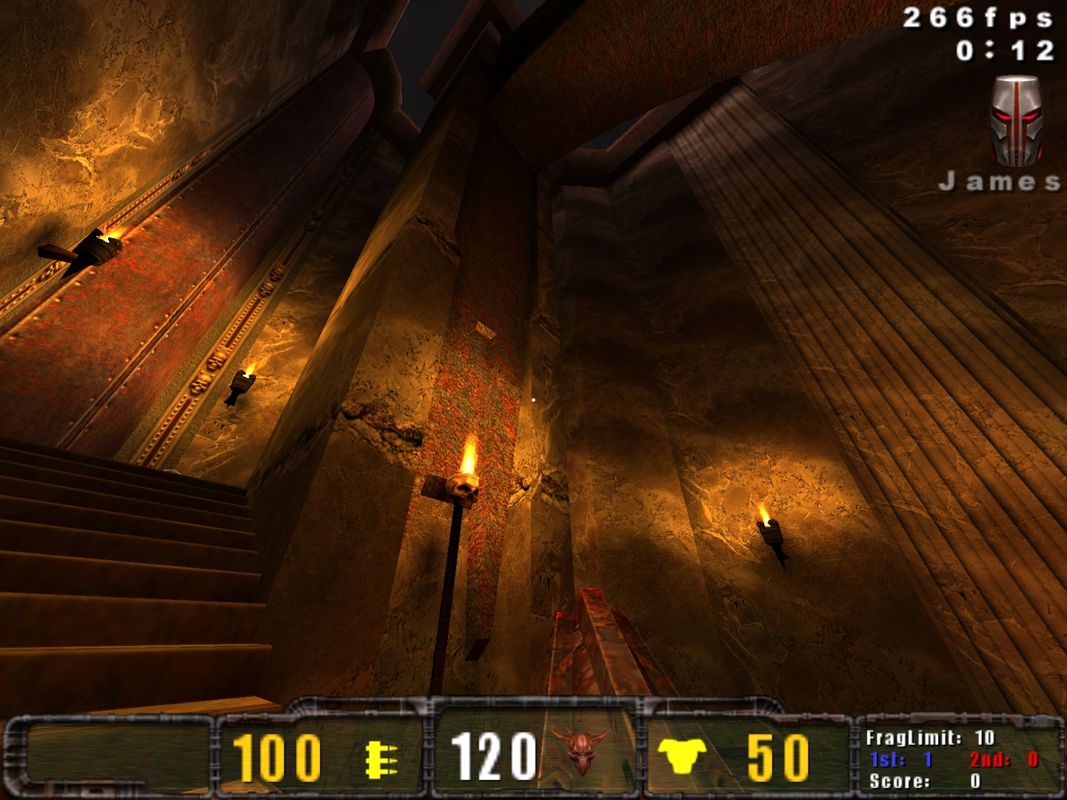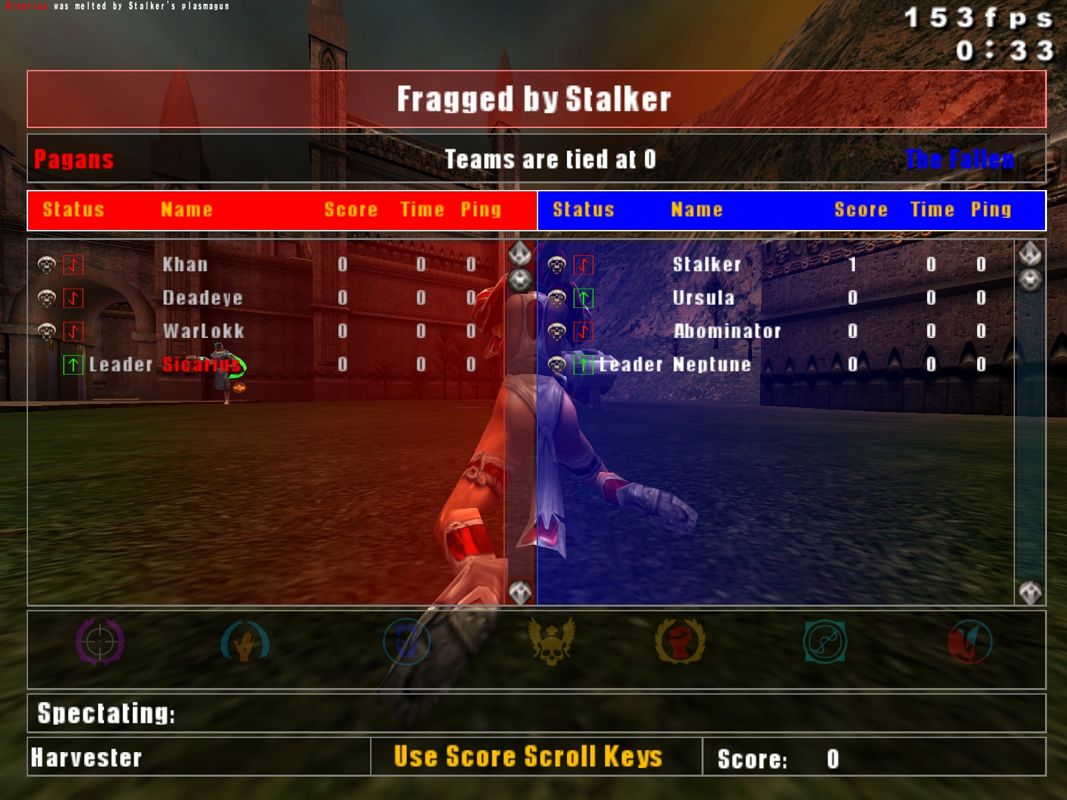Retro Replay Review
Gameplay
Quake III: Team Arena transforms the frenetic, free-for-all combat of its predecessor into a tightly choreographed testament to teamwork and strategy. The introduction of three new team-based modes—Harvester, Overload, and One Flag—encourages coordinated assaults and defensive maneuvers. In Harvester, squads fight to collect head fragments from fallen enemies, adding a macabre twist to the familiar frag count. Overload tasks each team with charging their opponent’s power core using stolen armor shards, turning every skirmish into a tug-of-war for map control. One Flag, the most classic of the trio, revitalizes Capture the Flag with a single neutral banner and hectic mid-field exchanges.
Beyond objectives, Team Arena adds a light class system via new power-ups that resemble a Team Fortress–style structure. Players can temporarily assume roles such as defender or runner, based on whether they pick up armor or speed boosts. This subtle role specialization deepens squad interactions without locking you into a rigid character choice. Additionally, a trio of fresh weapons—the nail gun, chain gun, and proximity mine launcher—expands your tactical palette. The nail gun’s rapid-fire quills are perfect for close-quarters bursts, the chain gun can suppress chokepoints with sustained fire, and proximity mines turn narrow corridors into lethal ambush zones.
Single-use items inject further unpredictability into each match. Kamikaze, for instance, lets you detonate yourself in a colossal explosion, wiping out clustered foes (and sacrificing your own lifepoints). Invulnerability suspends you mid-air in a glowing bubble, granting temporary immunity at the cost of mobility. These cinematic power plays keep adrenaline levels high and force both teams to adapt on the fly. With new levels designed specifically for these modes, every match feels fresh—even for veterans of the original Quake III Arena.
Graphics
While Team Arena doesn’t overhaul the id Tech 3 engine, it layers in subtle enhancements that heighten the sensory experience. Doppler-shift effects on rockets and grenades, for example, add a visceral sense of speed and danger as ordnance whizzes past your view. The new maps showcase refined lighting gradients and richer textures, from the oil-slick metallic corridors of Overload arenas to the sun-drenched stonework in Harvester chambers. Though the engine is approaching its twilight, these tweaks keep the visuals feeling sharp and engaging.
Environmental details receive a notable uplift in Team Arena. Holographic displays, flickering neon textures, and animated surface reflections give the arenas a lived-in, industrial sci-fi ambience. Particle effects for explosions, rocket trails, and energy barriers are more pronounced, ensuring that every blast feels impactful. The expanded color palette—from acidic greens in toxic sludge pits to the bruised purples of hidden alcoves—helps distinguish each map’s identity, which is crucial in high-stakes, team-based modes where knowing your surroundings can mean the difference between victory and respawn.
Performance-wise, Team Arena remains impressively optimized. Even with all the new visual flair enabled, most mid-range machines of its era can hold steady frame rates at competitive resolutions. The UI retains its razor-sharp clarity, with scoreboards and power-up indicators neatly integrated into the heads-up display. In fast-paced matches, you rarely question whether the engine can keep up—your focus stays locked on outsmarting the opposing team rather than wrestling with graphical hiccups.
Story
Quake III: Team Arena, much like its parent game, eschews a deep narrative in favor of pure arena combat. The skeletal lore frames you as a gladiator fighting in intergalactic arenas run by unknown overlords. Each map feels like a distinct crucible designed to test skill, reflexes, and teamwork, though the connective tissue between levels remains intentionally minimal. For those seeking an epic tale, the narrative is limited to scant text snippets and tantalizing glimpses of off-screen machinations.
Despite the lack of a robust storyline, Team Arena’s unlockable items and unlock conditions create a sense of progression. Earning new weapons, power-ups, and maps through in-game achievements lends a light RPG-like gratification. You may find yourself replaying Harvester matches not just for the thrill of victory, but also to unlock that final bonus arena or to secure access to the most destructive power-up. In this way, the game crafts its own meta-narrative based on player-driven milestones rather than scripted cutscenes.
For many, the absence of a defined plot is a feature, not a bug. By focusing squarely on multiplayer dynamics, Team Arena delivers an experience that thrives on replayability and emergent storytelling—each match writes its own tale of triumphs, betrayals, and clutch plays. Fans of arena shooters will appreciate that the narrative void only amplifies the immediacy of competition, placing every frag and flag capture at the heart of the action.
Overall Experience
Quake III: Team Arena stands as a compelling expansion that broadens the tactical horizons of its landmark predecessor. Its emphasis on team-based objectives brings a fresh layer of strategy to the pick-up-and-play formula. Matches feel more purposeful than in classic free-for-all modes, yet the core mechanics remain as tight and responsive as ever. This delicate balance between familiarity and innovation is the expansion’s greatest achievement.
Longevity is another strong suit. With multiple game types, new weapons, diverse power-ups, and challenging unlock paths, there’s ample reason to return long after the initial thrill. The learning curve is generous—novices can jump into a One Flag match and score a few clutches, while hardcore veterans can refine advanced tactics in Overload’s high-stakes vortex of combat. And of course, community-hosted servers and custom mods continue to keep the ecosystem vibrant.
All told, Quake III: Team Arena is a must-have for anyone who still derives joy from lightning-fast arena shooters. It doesn’t reinvent the wheel, but it adds meaningful tread to ensure your wheels stay gripping the pavement. Whether you’re seeking team-centric thrills or simply more weapons and maps to master, this expansion delivers a package that feels both substantial and seamlessly integrated.
 Retro Replay Retro Replay gaming reviews, news, emulation, geek stuff and more!
Retro Replay Retro Replay gaming reviews, news, emulation, geek stuff and more!









Reviews
There are no reviews yet.